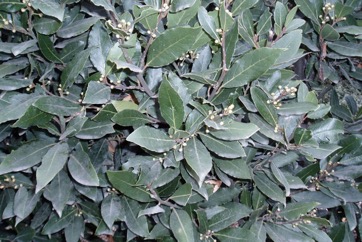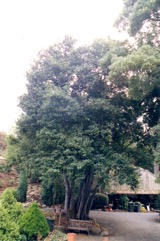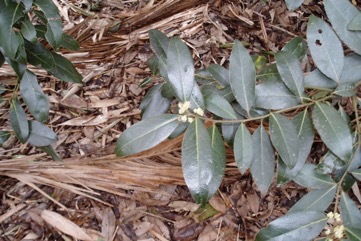Bay laurel, Sweet Bay

It suits Mediterranean climates with hot dry summers and cool, wet winters. It needs full sunlight in cooler places but some shade in tropical places. It needs a rich well drained soil. It can tolerate dry conditions. In Melbourne Botanical Gardens. In Hobart Botanical gardens. It can handle light frosts. It can stand temperatures down to -15°C. It suits hardiness zones 8-11. Wittunga Botanical Gardens. In Sichuan and Yunnan. Arboretum Tasmania.
Also known as:
Alloro, Bay, Dapna, Daun salam bei, Defne, Define, Depne, Gekkeiju, Ghar, Grecian laurel, Lager, Laurier, Lauro, Lavr, Llor, Lorbeer, Louriero, Louro, Lovorika, Navadni lovor, Noble laurel, Orbaco, Poet's laurel, Roman laurel, Sweet laurel, Tehnel, Tejpata, Tenel, Tenyel, Wreath laurel, Yue gui, Yueh-kuei
Edible Portion
- Leaves, Herb, Spice, Oil
Where does Bay laurel grow?
Found in: Africa, Albania, Asia, Australia, Balkans, Bangladesh, Bosnia, Brazil, Britain, Caucasus, China, Crete, Croatia, Cyprus, Europe, France, Georgia, Greece, Guatemala, Hawaii, India, Indochina, Indonesia, Israel, Italy, Japan, Jordan, Korea, Lebanon, Mediterranean, Mexico, Morocco, Nigeria, North Africa, North America, Pacific, Palestine, Portugal, Romania, Russia, San Marino, SE Asia, Sicily, Slovenia, South Africa, South America, Southern Africa, Spain, Syria, Taiwan, Tasmania, Turkey, United States, Vietnam, West Africa, Yugoslavia
Notes: There are 2 Laurus species.
Status: The leaves are a popular herb. It is a cultivated food plant.
Growing Bay laurel, Sweet Bay
Cultivation: Plants are difficult to grow from seed. Fresh green shoots or tip cuttings are best for growing new plants. An 8 cm cutting from a mature plant should be used and some leaves removed. Dipping the root in root hormone will help. Cuttings may take 9 months to root and be ready for transplanting. Plants can also be grown by layering and by using suckers from the base. Plants can be pruned into a hedge.
Edible Uses: Leaves are used raw or dried as flavouring in soups, stews and sauces. They are also used in stuffings and gravies. The dried fruit and leaf oil are also used for flavouring. Dried leaves are brewed into a herbal tea. CAUTION: The berries are poisonous.
Production: A very slow growing tree. Leaves are picked early in the day throughout the year. They can be used fresh or dried. To dry leaves, they should be weighed down to prevent curling and dried in a dark, airy room. Dried leaves should be stored in sealed jars.
Nutrition Info
per 100g edible portion| Edible Part | Energy (kcal) | Protein (g) | Iron (mg) | Vitamin A (ug) | Vitamin c (mg) | Zinc (mg) | % Water |
|---|---|---|---|---|---|---|---|
| Leaf | 314 | 7.6 | 43 | 619 | 46.5 | 3.7 | 5.4 |
Bay laurel, Sweet Bay Photos



References
Ali, A. M. S., 2005, Homegardens in Smallholder Farming Systems: Examples from Bangladesh. Human Ecology, Vol. 33, No. 2 pp. 245-270
Ambasta, S.P. (Ed.), 2000, The Useful Plants of India. CSIR India. p 319
Arora, R. K., 2014, Diversity in Underutilized Plant Species - An Asia-Pacific Perspective. Bioversity International. p 105
Bianchini, F., Corbetta, F., and Pistoia, M., 1975, Fruits of the Earth. Cassell. p 206
Blamey, M and Grey-Wilson, C., 2005, Wild flowers of the Mediterranean. A & C Black London. p 50
Bodkin, F., 1991, Encyclopedia Botanica. Cornstalk publishing, p 622
Bonet, M. A. & Valles, J., 2002, Use of non-crop food vascular plants in Montseny biosphere reserve (Catalonia, Iberian Peninsula). International Journal of Food Sciences and Nutrition (2002) 53, 225–248
Bremness, L., 1994, Herbs. Collins Eyewitness Handbooks. Harper Collins. p 61
Brouk, B., 1975, Plants Consumed by Man. Academic Press, London. p 282
Brown, D., 2002, The Royal Horticultural Society encyclopedia of Herbs and their uses. DK Books. p 252
Burnie, G & Fenton-Smith, J., 1999, A Grower's Guide to Herbs. Murdoch Books. p 14
Bussman, R. W., et al, 2016, A comparative ethnobotany of Khevsureti, Samtskhe-Javakheti, Tusheti, Svaneti, and Racha-Lechkhumi, Republic of Georgia (Sakartvelo), Caucasus. Journal of Ethnobiology and Ethnomedicine (2016) 12:4
Bussman, R. W. et al, 2017, Ethnobotany of Samtskhe-Javakheti, Sakartvelo (Republic of Georgia), Caucasus. Indian Journal of Traditional Knowledge Vol. 16(1) pp 7-24
Cheifetz, A., (ed), 1999, 500 popular vegetables, herbs, fruits and nuts for Australian Gardeners. Random House p 131
Ciftcioglu, C. G., 2015, Sustainable wild-collection of medicinal and edible plants in Lefke region of North Cyprus. Agroforest Syst. Springer
Coombes, A.J., 2000, Trees. Dorling Kindersley Handbooks. p 188
Cundall, P., (ed.), 2004, Gardening Australia: flora: the gardener's bible. ABC Books. p 800
Davis, S.D., Heywood, V.H., & Hamilton, A.C. (eds), 1994, Centres of plant Diversity. WWF. Vol 2. p 340
Della, A., et al, 2006, An ethnobotanical survey of wild edible plants of Paphos and Larnaca countryside of Cyprus. J. Ethnobiol. Ethnomed. 2:34
Dogan, Y., et al, 2004, The Use of Wild Edible Plants in Western and Central Anatolia (Turkey). Economic Botany 58(4) pp. 684-690
Dolina, K. & Luczaj, L., 2014, Wild food plants used on the Dubrovnik coast (south-eastern Croatia) Acta Soc Bot Pol 83(3):175–181
Ertug, F., 2004, Wild Edible Plants of the Bodrum Area. (Mugla, Turkey). Turk. J. Bot. 28 (2004): 161-174
Ertug, F, Yenen Bitkiler. Resimli Türkiye Florası -I- Flora of Turkey - Ethnobotany supplement
Esperanca, M. J., 1988. Surviving in the wild. A glance at the wild plants and their uses. Vol. 1. p 81
Etherington, K., & Imwold, D., (Eds), 2001, Botanica's Trees & Shrubs. The illustrated A-Z of over 8500 trees and shrubs. Random House, Australia. p 425
Facciola, S., 1998, Cornucopia 2: a Source Book of Edible Plants. Kampong Publications, p 139
Gonzalez, J. A., et al, 2011, The consumption of wild and semi-domesticated edible plants in the Arribes del Duero (Salamanca-Zamora, Spain): an ananalysis of traditional knowledge. Genetic Resources and Crop Evolution 58:991-1006
Gunes, S. et al, 2018, Survey of wild food plants for human consumption in Karaisali (Adana-Turkey). Indian Journal of Traditional Knowledge. Vol. 17(2), April 2018, pp 290-298
Gurdal, B. & Kultur, S., 2014, The edible and miscellaneous useful plants in Marmaris (Southwest Turkey). İstanbul Ecz. Fak. Derg. / J. Fac. Pharm. Istanbul 44(1) 2014 pp.69-78
Hadfield, J., 2001, The A-Z of Vegetable Gardening in South Africa. Struik p 134
Hancer, C. K., et al, 2020, Traditional Knowledge of Wild Edible Plants of Biga (Çanakkale), Turkey. Acta Societatis Botanicorum Poloniae / 2020 / Volume 89 / Issue 1 / Article 8914
Hedrick, U.P., 1919, (Ed.), Sturtevant's edible plants of the world. p 374
Hemphill, I, 2002, Spice Notes. Macmillan. p 68
Hibbert, M., 2002, The Aussie Plant Finder 2002, Florilegium. p 179
Hinnawi, N. S. A., 2010, An ethnobotanical study of wild edible plants in the Northern West Bank "Palestine". An-Najah National University. p 93
http://www.botanic-gardens-ljubljana.com/en/plants
Joyce, D., 1998, The Garden Plant Selector. Ryland, Peters and Small. p 146
Kayabasi, N. P., et al, 2018, Wild edible plants and their traditional use in the human nutrition in Manyas (Turkey). Indian Journal of Traditional Knowledge. Vol. 17(2), April 2018, pp 299-306
Kiple, K.F. & Ornelas, K.C., (eds), 2000, The Cambridge World History of Food. CUP p 432, 1728
Kizilarslan, C. & Ozhatay, N., 2012, An ethnobotanical study of the useful and edible plants of İzmit. Marmara Pharmaceutical Journal 16: 134-140, 2012.
Kremer, B.P., 1995, Shrubs in the Wild and in Gardens. Barrons. p 91
Kybal, J., 1980, Herbs and Spices, A Hamlyn Colour Guide, Hamlyn Sydney p 114
Lazarides, M. & Hince, B., 1993, Handbook of Economic Plants of Australia, CSIRO. p 145
Licata, M., et al, 2016, A survey of wild plant species for food use in Sicily (Italy) – results of a 3-year study in four Regional Parks. Journal of Ethnobiology and Ethnomedicine 12:12
Li Xi-wen, Li Jie, Huang Puhua, van der Werff, H., Lauraceae. Flora of China.
Lord, E.E., & Willis, J.H., 1999, Shrubs and Trees for Australian gardens. Lothian. p 57
Menendez-Baceta, G., et al, 2012, Wild edible plants traditionally gathered in Gorbeialdea (Biscay, Basque Country) Genetic Reources and Crop Evolution 59:1329-1347
Mulherin, J., 1994, Spices and natural flavourings. Tiger Books, London. p 28
Nassif, F., & Tanji, A., 2013, Gathered food plants in Morocco: The long forgotten species in Ethnobotanical Research. Life Science Leaflets 3:17-54
Nebel, S., Pieroni, A. & Heinrich, M., 2006, Ta cho`rta: Wild edible greens used in the Graecanic area in Calabria, Southern Italy. Appetite 47 (2006) 333–342
Onuminya, T. O., et al, 2017, Comparative proximate and Phytochemical Analysis of leafy vegetables in Lagos State. Nig. J. Pure and Applied Sci. Vol. 30 Issue 3: p 3097f
Oran, S. A. S., 2015, Selected Wild Aromatic Plants in Jordan. International Journal of Medicinal Plants. Photon 108 (2015) 686-699
Özdemir, E. and Kültür, S., 2017, Wild Edible Plants of Savaştepe District (Balıkesir, Turkey), Marmara Pharm J 21/3: 578-589
Pardo-de-Santayana, M., et al, 2005, The gathering and consumption of wild edible plants in the Campoo (Cantabria, Spain). International Journal of Food Sciences and Nutrition. 56(7): 529-542
Pham-Hoang Ho, 1999, An Illustrated Flora of Vietnam. Nha Xuat Ban Tre. p 375
Phillips, R. & Rix, M., 2002, The Botanical Garden Vol. 1. Trees and Shrubs. MacMillan. p 66
Pieroni, A., et al, 2012, "We are Italians!": The Hybrid Ethnobotany of a Venetian Diaspora in Eastern Romania. Human Ecology 40:435-451
Purseglove, J.W., 1968, Tropical Crops Dicotyledons, Longmans. p 187
Raghavan, S., 2007, Handbook of Spices, Seasonings, and Flavourings. Second Edition. CRC Press p 70
Redzic, S. J., 2006, Wild Edible Plants and their Traditional Use in the Human Nutrition in Bosnia-Herzegovina. Ecology of Food and Nutrition, 45:189-232
Rigat, M et al, 2009, Ethnobotany of Food Plants in the High River Ter Valley (Pyrenees, catalonia, Iberian Peninsula): Non-Crop Food Vascular Plants and Crop Food Plants with medicinal Properties. Ecology of Food and Nutrition, 48:303-327
Ryan, S., 2008, Dicksonia. Rare Plants Manual. Hyland House. p 36
Sansanelli, S., et al, 2014, Wild food plants traditionall consumed in the area of Bologna (Emilia Romagna region, Italy). Journal of Ethnobiology and Ethnomedicine 10:69
Schuler, S., (Ed.), 1977, Simon & Schuster's Guide to Trees. Simon & Schuster. No. 133
Seidemann J., 2005, World Spice Plants. Economic Usage, Botany, Taxonomy. Springer. p 199
Self, M., 199, Phoenix Seeds catalogue. p 17
Sfikas, G., 1984, Trees and shrubs of Greece. Efstathiadis Group. Athens. p 58
Sinclair, V., 1992, The Floral Charm of Cyprus. Interworld Publications. p 137
Solomon, C., 2001, Encyclopedia of Asian Food. New Holland. p 25
Sp. pl. 1:369. 1753
Staples, G.W. and Herbst, D.R., 2005, A tropical Garden Flora. Bishop Museum Press, Honolulu, Hawaii. p 367 (Drawing)
Sukarya, D. G., (Ed.) 2013, 3,500 Plant Species of the Botanic Gardens of Indonesia. LIPI p 658
Tardio, J., et al, Ethnobotanical review of wild edible plants in Spain. Botanical J. Linnean Soc. 152 (2006), 27-71
van Wyk, B., 2005, Food Plants of the World. An illustrated guide. Timber press. p 225
World Checklist of Useful Plant Species 2020. Royal Botanic Gardens, Kew